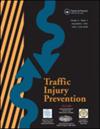Adult-supervised practice in learner’s permit phase has a significant but limited ability to improve safe driving skills
IF 1.6
3区 工程技术
Q3 PUBLIC, ENVIRONMENTAL & OCCUPATIONAL HEALTH
引用次数: 0
Abstract
Objectives
Most U.S. states require adult-supervised practice for adolescent learner permit holders intending to obtain a driver’s license before 18. However, the effectiveness of adult-supervised practice in imparting safe driving skills had been inconclusive prior to the recent development of consistent measures of adolescent learners’ driving performance. We examined the relationship between the number of adult-supervised practice hours and driving performance and skill deficits for 441 learner permit holders ages 16 and 17 in Pennsylvania.
Methods
Data came from a virtual driving assessment (VDA) deployed across Children’s Hospital of Philadelphia’s Primary Care Network and a self-reported survey at the time of the VDA. Based on a previous study, we defined two VDA Driving Classes that describe driving performance: Major Issues or Major Issues with Dangerous Behavior Class, and Minor Issues or No Issues Class. The response options for adult-supervised practice hours were presented to adolescents as categories (none, <15 h, 15–<65 h, 65 h, and >65 h). We grouped those with 65 h with those with >65 h given the low numbers of responses in these categories. The analysis used a Chi-square test and a binomial logit to investigate how adult-supervised practice hours correspond to adolescents’ VDA Driving Classes.
Results
Chi-square test showed weak associations between VDA Driving Classes and adult-supervised practice hours. The binomial logit found that adolescents who reported zero adult-supervised practice hours were more likely to be classified into the Major Issues or Major Issues with Dangerous Behavior Class than those who reported adult-supervised practice hours. For those who reported adult-supervised practice, the differences in VDA Driving Class were not statistically significant across the three practice categories (i.e., <15 h, 15–<65 h, and 65 h). The model found no significant associations between VDA Driving Class and whether adolescent learners reported practicing with a formal instructor.
Conclusions
Our findings suggest that under current adult-supervised practice routines, longer practice hours have limited associations with improvements in adolescents’ VDA Driving Class. Some adolescents might not be ready to deal with the more dangerous settings the VDA presents even after completing the required hours of adult-supervised practice.
在学车阶段,成人监督下的练习对提高安全驾驶技能有显著作用,但作用有限。
目标:美国大多数州都要求在 18 岁之前获得驾照的青少年驾驶员在成人监督下进行驾驶练习。然而,在最近开发出青少年学员驾驶表现的一致测量方法之前,成人监督练习在传授安全驾驶技能方面的效果一直没有定论。我们研究了宾夕法尼亚州 441 名 16 岁和 17 岁的驾驶执照持有者在成人监督下练习的小时数与驾驶表现和技能缺陷之间的关系:数据来源于费城儿童医院基层医疗网络部署的虚拟驾驶评估(VDA)以及 VDA 时的自我报告调查。根据之前的一项研究,我们定义了两个描述驾驶表现的 VDA 驾驶等级:重大问题或有危险行为的重大问题等级,以及轻微问题或无问题等级。我们将青少年在成人监督下的练习时数分为几类(无、65 小时)。鉴于回答 65 小时和大于 65 小时的青少年人数较少,我们将这两类青少年进行了分组。分析采用了卡方检验(Chi-square test)和二项对数检验(binomial logit),以研究成人监督练习时间与青少年 VDA 驾驶课程的对应关系:卡方检验显示,VDA驾驶课程与成人监督练习时数之间的关联较弱。二项logit发现,与报告有成人监督的练习时数的青少年相比,报告成人监督的练习时数为零的青少年更有可能被归入 "重大问题 "或 "有危险行为的重大问题 "类别。对于那些报告有成人监督练习的青少年来说,在三个练习类别(即≥65小时)中,VDA驾驶级别的差异在统计学上并不显著。模型发现,VDA驾驶级别与青少年学员是否报告在正式教练指导下练习之间没有明显关联:我们的研究结果表明,在目前成人监督的练习程序下,较长的练习时间与青少年 VDA 驾驶水平的提高之间的关系有限。有些青少年即使完成了成人监督下的规定练习时间,也可能还没有准备好应对 VDA 所带来的更危险的环境。
本文章由计算机程序翻译,如有差异,请以英文原文为准。
求助全文
约1分钟内获得全文
求助全文
来源期刊

Traffic Injury Prevention
PUBLIC, ENVIRONMENTAL & OCCUPATIONAL HEALTH-
CiteScore
3.60
自引率
10.00%
发文量
137
审稿时长
3 months
期刊介绍:
The purpose of Traffic Injury Prevention is to bridge the disciplines of medicine, engineering, public health and traffic safety in order to foster the science of traffic injury prevention. The archival journal focuses on research, interventions and evaluations within the areas of traffic safety, crash causation, injury prevention and treatment.
General topics within the journal''s scope are driver behavior, road infrastructure, emerging crash avoidance technologies, crash and injury epidemiology, alcohol and drugs, impact injury biomechanics, vehicle crashworthiness, occupant restraints, pedestrian safety, evaluation of interventions, economic consequences and emergency and clinical care with specific application to traffic injury prevention. The journal includes full length papers, review articles, case studies, brief technical notes and commentaries.
 求助内容:
求助内容: 应助结果提醒方式:
应助结果提醒方式:


